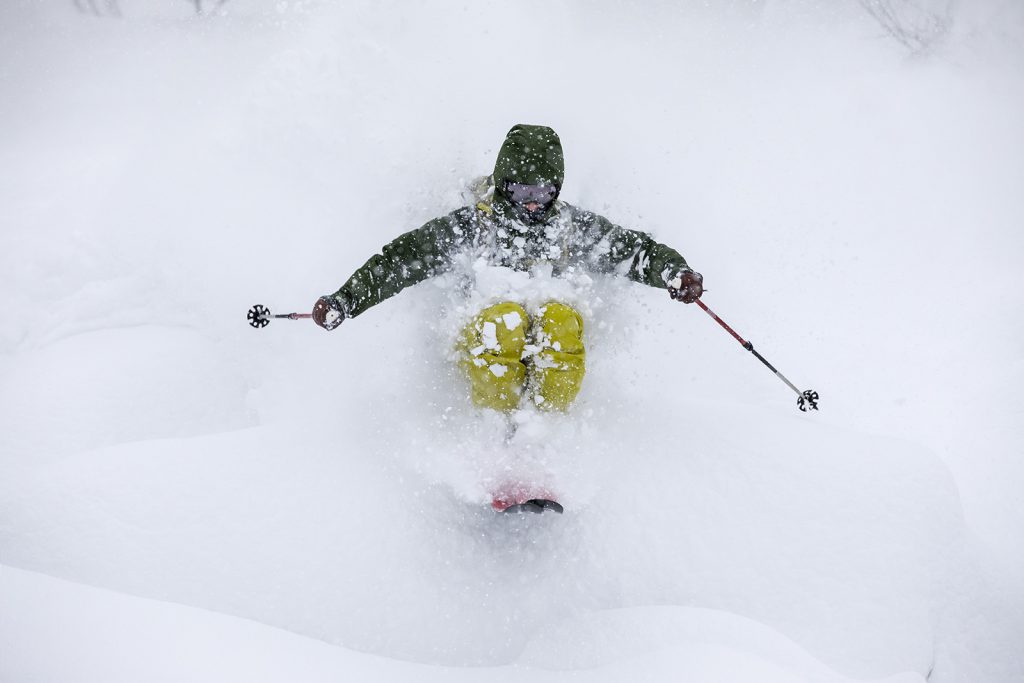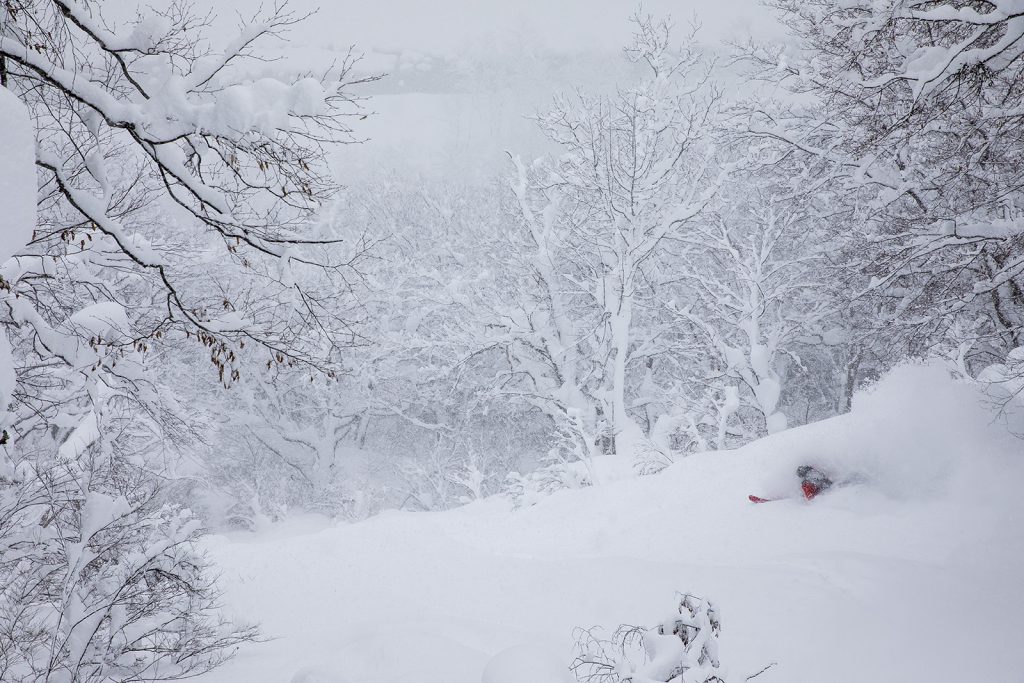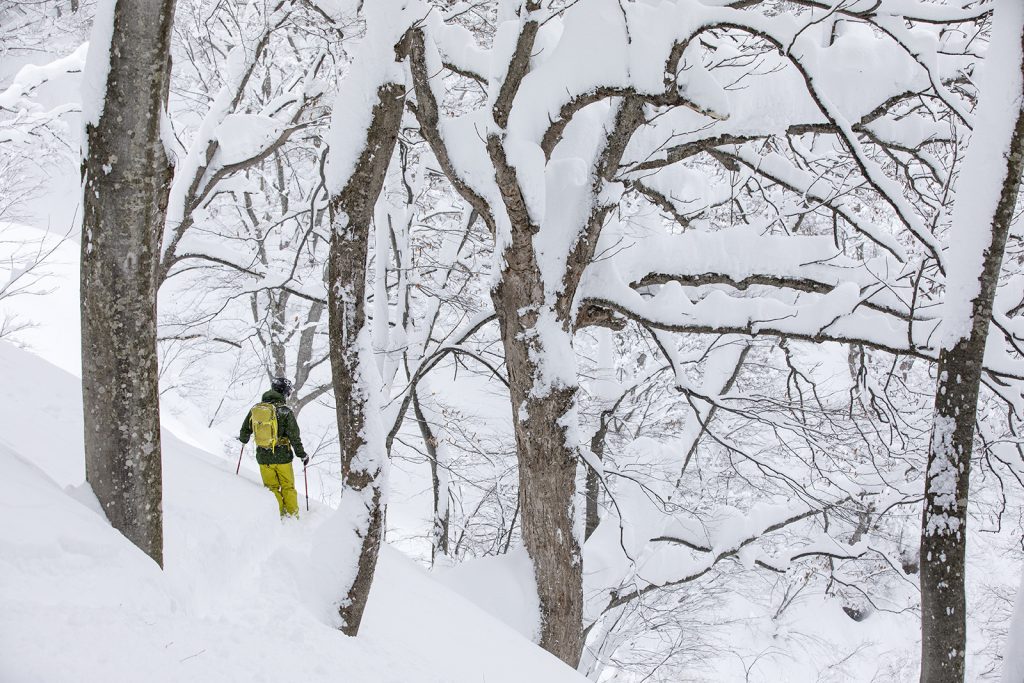In Search of Powder- An Englishman in Honshu, Japan


And just like that, we were back on terms. Suddenly everything was normal. Powder was a language we could speak and the enthralling but often unfathomable cultural bounties of Japan were drowned out by the beautiful hissing snow beneath our skis.
We’d left the Kagura resort transceiver gate in cloud to skin through a white birch forest to a north-south ridge. The wind had been blowing out of the west for two days so we’d opted to hit leeward slopes, reckoning they’d be crust-free. And, as we crested the ridge after 30 minutes, the cloud receded and we were in the sun.
We scalloped the eastern edge of the ridge into the valley below, sashaying through perfectly-spaced trees in the sort of conditions we hadn’t dare hope for when we woke to rain and cloud that morning. Untracked, thigh-deep powder beneath clear skies. This was how we’d imagined Japan. And, after a few days’ travelling through Japan’s biggest island of Honshu, it felt like coming home.
When all the demonstrable aspects of a culture are so hugely different to your own – from the language and the food to the dizzying etiquette – then it’s an adventurous soul that doesn’t seek temporary solace in the familiar. And, as we probably wouldn’t be visiting an Irish pub or a Starbucks, then skiing would be our anchor. Of course, the Japanese culture is fascinating. There are few countries so different to ours but so developed at the same time. But it’s good to have a bolthole where things feel a bit less… odd.
And if the backcountry environment felt suddenly comfortingly familiar, then the people we met on the slopes even more so – all cultural differences disappear once you have skis on your feet. The whole of the day we had in the Niigata prefecture resort of Kagura, our guide hardly shared a word directly with us. Local Jun Nagai issued infrequent instructions through our bilingual resort host. Yet we had a complex, multi-faceted understanding.
Kagura and its linked sister resort of Naeba have 22 pistes serving 25km of slopes, which together make up an area called Mount Naeba. But, we weren’t here to session its groomers – we had enlisted Jun to show us Kagura’s backcountry goods. Thanks to its high elevation (1800m), the resort receives an abundance of light, dry powder snow each year, enjoying the longest ski season in Japan. And, what with it receiving much smaller visitor numbers compared with Japan’s more mainstream resorts, you can find fresh snow several days after a snowfall.
Measuring and logging snow-layer depths, temperatures, and wind speed and direction, Jun, in his early-30s, was as relaxed as he was taciturn. Allowing us to push on ahead for photos, in the end he was happy for us to take pretty much any line we fancied.
When we reached the frozen river in the bottom of the valley and had lunch, Jun watched on in quiet amusement as we sessioned a drop-off for the camera.
We’d brought with us our new favourite hill food: onigiri. Sticky rice blocks in various flavours and one of a host of Japanese hacks we’d gleaned from our Hakuba guide, Alaskan Bill Glude, a few days before. Simple carbohydrate to fuel our skin back up to the ridge before we skied another series of untracked twisting pitches through the trees back to the piste.

I had travelled to Japan with a couple of friends to explore some of the main island’s best ski areas. Our visit to Mount Naeba had been preceded by a two-day stay in the Hakuba valley in the Nagano Prefecture, around 100 miles south-west by train.
Hakuba enjoys similar snow conditions to the famous Niseko resorts on the northern island of Hokkaido, but is far easier to get to from Tokyo. Taking the Shinkansen – bullet train – north-west out of Tokyo, we’d been at the gateway to the Nagano area, known as the ‘Japanese Alps’, in under two hours. A short bus transfer into the Hakuba Valley had landed us at the Happo-One, the biggest of the valley’s 10 resorts with 50km of runs served by 22 lifts.
Exloring the region does require a little more effort – and planning – though. Unlike Niseko, whose four resorts and 50km of pistes are connected, you need a bus to travel between the Hakuba valley resorts.
Happo One was the venue for the ski jump in the 1998 Olympics and is now a regular on the Freeride World Tour circuit. It has a fine backcountry pedigree partly thanks to local guiding company Evergreen Alpine Academy, and we were excited to sample its best bits with legendary local and ski guide Bill Glude. Aka Bill the Beard (he has a very fine one indeed), Bill is approaching his 14th season guiding in Japan. He splits his Evergreen guiding with a job as an avalanche consultant back in his AK hometown of Juneau. So it’s little surprise he has some wisdom to impart.
A strong west wind had brought a warm storm from China, and rain at resort level in the Hakuba Valley had dampened our expectations. But trusty Bill had a plan: head for the neighbouring resort of Tsugaike Kogen instead, where good snow was likely to be found on the north and east-facing slopes.
Twenty minutes drive north-east from Happo One, the small resort with just 20km of piste was clearly the spot on the day. In a charming reminder of the technological disparity that this country enjoys, the day’s second lift was an ageing fixed grip lift (an old, non-detachable lift, the sort that goes at one speed and hits you in the legs), which we had to pay the liftie for in cash.
After an hour’s skin from the top, we emerged on a windy ridge, the richer for many of Bill’s life lessons and anecdotes that he’d shared en route, along with some new words – not just Japanese ones. Like most of the Evergreen guides, Bill explains he’s ‘bishredual’, in that he skis and splitboards.
With the cloud coming in and out, bishredual Bill opted to drop down the back of the ridge earlier than planned. A cornice forced us on to a fairly loaded pitch, which he prodded with a sweetly executed cut before we dropped in.
The wind had pushed in a whole heap of fresh overnight and while it was a little stiff through the wind-blown roll in at the top, we were soon floating through wide spaced trees spread across a series of natural half-pipe gulleys that fed us down to a flat meadow. It was decent depth and we were euphoric after our damp start. We lapped the back bowl three times until our damp skins were staring to peel.
On the way back Bill said that in the past skiers would be guaranteed powder in Hakuba but he reckoned global warming meant that was no longer the case. “We get rain now. We always did but we definitely get more now,” he said. “But we still get a ton of snow, around 11 metres a year, much more than we get in Alaska. Alaskans find that difficult to believe but there it is.”

When we’d arrived back after the Kagura tour, guide Jun had admitted he’d been anxious about the conditions for our tour with him. For while Japan’s northern island of Hokkaido had been drowning in powder, the Japanese Alps had been unseasonably warm.
Indeed, we’d left the luxury of our base at the Naeba Prince Hotel and stayed the night before in the piste-side Wadagoya hut in the Naeba resort at 1400m and, although we’d woken up to fresh snow, the freezing level had only just been below it.
The hut sleeps 32 guests in futon-filled dorms off the main communal area where meals are served around an open fire. Included in the £60 a night rate is automatic first tracks before other skiers have the chance to make it up the mountain. We’d cruised the fast pistes most of the day with no fresh tracks in sight, and weren’t hugely optimistic about finding powder in Kagura the day after.
In fact, as we found out later, it had just been loading up the high backcountry for us. Plus the wind and low visibility – only clearing as we’d approached – had kept almost everyone out to give us a day we’d never forget.
Jun’s experience and attention to detail had led us to the best lines, exploring the virgin bowls and forests of Kagura in bright sunshine, barely another sole in sight. While he only had a few words of English, he definitely spoke our language.
Indeed, that night I’d sat next to the former leader of the Mount Naeba ski patrol at dinner. Now manager of skiing for Prince Hotels’ Naeba operation, Masatoshi Imaizumi’s English was about as extensive as my Japanese, but it made no odds. Our common love for skiing – with a little help from our smartphones and a bucket of local spirit sake – had us laughing and joking like we were old pals. What a great and powerful thing.

TRAVEL
Japan Airlines flies from London Heathrow to Tokyo from £549. A Japan Rail Pass costs from £199 for an adult for seven days via Toptour Europe. For more information visit the Japan National Tourism Organisation.
SKI
Mount Naeba day joint lift pass costs £41. Happo One day lift pass costs £40. Tsugaike Kogen day lift pass costs £36.
Junrina Mountain Service offers ski guiding in Kagura from £85 per person per day.
Evergreen Alpine Academy offers an ‘introduction to off-piste and freeride’ in Happo One and its surrounding resorts from £145 per person per day.
STAY
THE NAEBA PRINCE HOTEL has doubles from £185 per night, including breakfast.
Honshino Resorts KAI Alps in Omachi, Nagano has accomodation in a Japanese-style room from £160 per night, including breakfast and dinner.
One night at the Wadagoya Mountain Hut starts from £60 per adult, £48 per child, including dinner and breakfast and first access to the slopes.